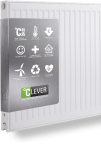Interview A
- Contents
- Interview with Mikko Iivonen
- It’s time to change our way of thinking
- How insulation influences heating efficiency
- Interview with Professor Christer Harryson
- The increasing use of low temperature water systems
- Interview with Professor Dr. Jarek Kurnitski
- Significant proof
- Choosing a heat emitter
- Interview with Elo Dhaene
- Benefits to the end user
M. Sc. (Tech) Mikko Iivonen, Director of Technical Environment and Standards, Rettig ICC
As Director of Technical Environment and Standards in Rettig ICC, I am responsible for providing all our markets with new answers, insights, innovations, products and results. All our efforts are based on realistic and independent research conducted in close co-operation with leading industry figures and academics. This has recently included Prof. Dr. Leen Peeters (University of Brussels - Belgium), Prof. Christer Harrysson (Örebro University - Sweden), Prof. Dr. Jarek Kurnitski (Helsinki University of Technology - Finland), Dr. Dietrich Schmidt (Fraunhofer Institut – Germany) and many others. With their help, research and insight, I turn figures into results.
Clever heating solutions
It is possible to save up to 15% on energy
By investing heavily in research and development, we live up to our promise to provide you with clever heating solutions. Solutions that make a real difference in terms of cost, comfort, indoor climate and energy consumption. Solutions that make it possible to save up to 15% on energy. With that in mind, I would like to share with you the results of an extensive one-year measurement study conducted by Professor Harrysson. The study involved 130 large and small Swedish family houses and shows that the heating energy consumption of underfloor-heated buildings is 15-25% higher than in radiator-heated buildings. That’s not surprising, but it also shows that the increased energy efficiency of modern buildings has once again put low temperature heating systems firmly in the spotlight.
Because of stricter requirements, the building envelope becomes easier to heat
As you can see in Fig. A.1 and A.2, the design temperatures of radiators have decreased over the years in accordance with the building energy requirements. As building and insulation requirements have become stricter across Europe, the building envelope becomes easier to heat, since less heat escapes. Furthermore, with the excellent responsiveness of a radiator system, it is now more practical than ever to make the most of heat gains in the home and office.
20/20/20
Primary energy saving target of 20%, reducing greenhouse gases by 20% and 20% of gross final energy has to come from renewable energies
European member states are on a fixed deadline to create and enforce regulations to meet Energy Efficiency Goals for 2020 (Directive 20/20/20). This involves reaching a primary energy saving target of 20% below 2007 levels, reducing greenhouse gases by 20%, and a determination that 20% of gross final energy has to come from renewable energies. For building owners tasked with providing ever more impressive Energy Performance Certificates, it is more important than ever to choose a heating system that offers proven improvements in energy efficiency - radiators in a low temperature system. These targets concern particularly buildings, which consume 40% of the total energy used in Europe.






